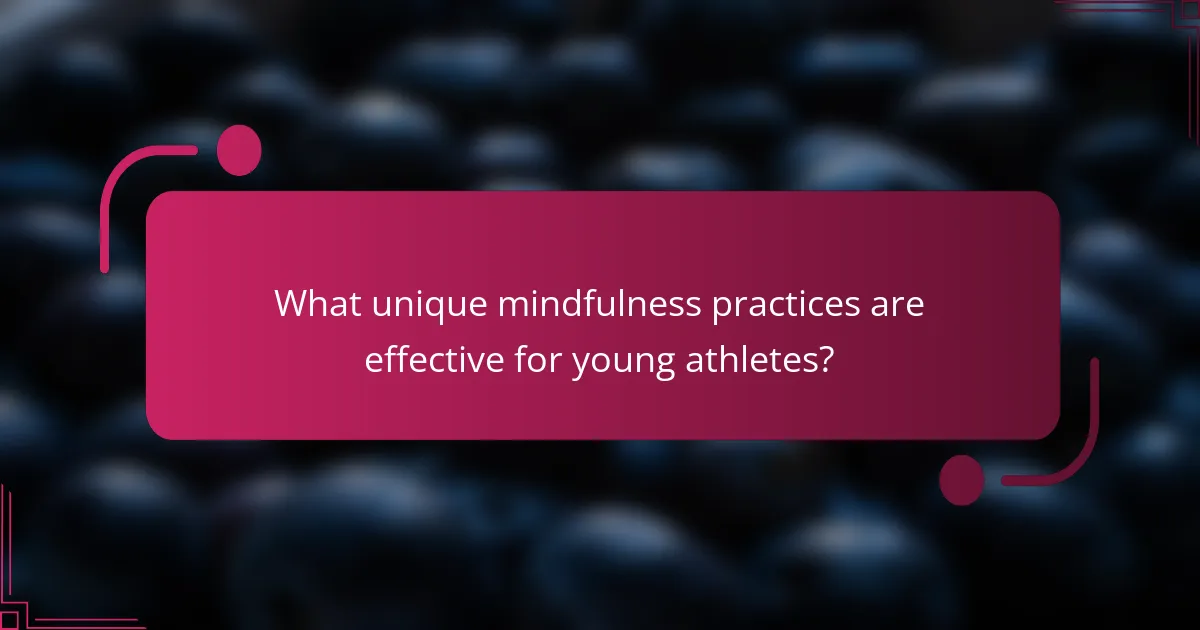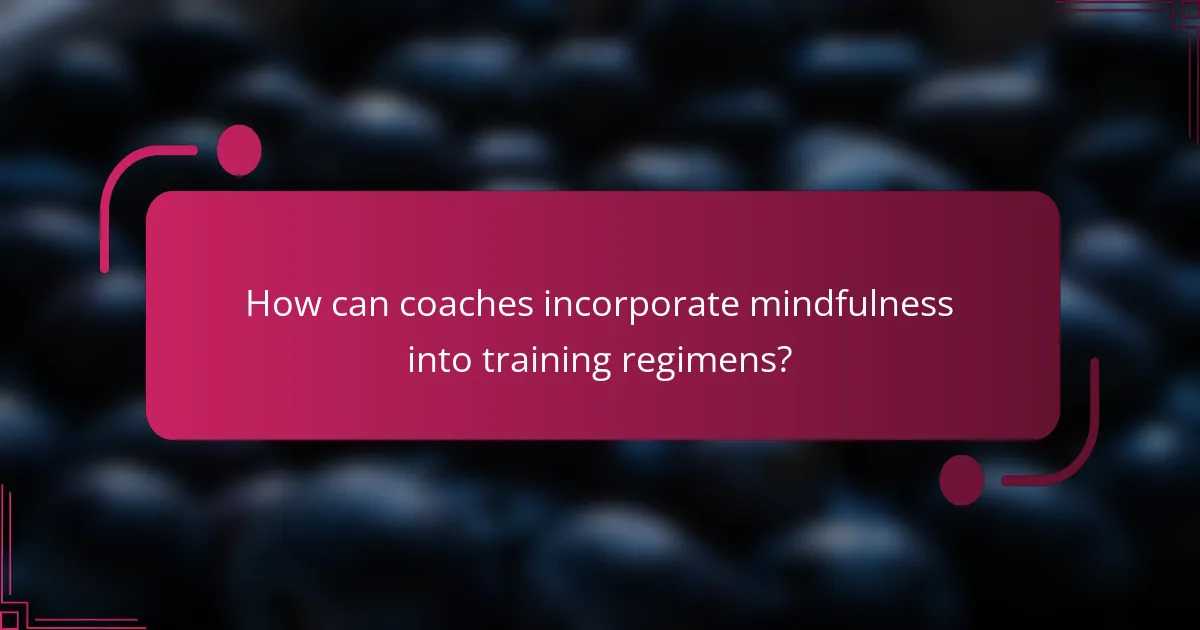Mindfulness techniques can significantly enhance the performance of young athletes by improving focus and reducing anxiety. This article explores various practices such as breathing exercises, visualization, and body scanning. It discusses the benefits of these techniques, including emotional regulation and resilience, as well as their effectiveness in fostering a positive athletic experience. Additionally, it provides insights on how coaches can integrate mindfulness into training regimens for optimal results.

What are the key mindfulness techniques for young athletes?
Mindfulness techniques for young athletes include breathing exercises, visualization, and body scanning. These practices enhance focus, reduce anxiety, and improve performance. Breathing exercises help regulate emotions, while visualization prepares athletes mentally for competition. Body scanning increases awareness of physical sensations, fostering a mind-body connection essential for peak performance.
How can breathing exercises enhance athletic performance?
Breathing exercises can significantly enhance athletic performance by improving oxygen intake, reducing stress, and increasing focus. These techniques help athletes maintain optimal physical condition and mental clarity during competitions.
Practicing deep breathing can enhance lung capacity, allowing for better endurance. Research indicates that athletes who incorporate breathing exercises into their training routines often experience improved performance metrics. For instance, controlled breathing can lower heart rates and enhance recovery times.
Mindfulness techniques, including breathing exercises, also contribute to mental resilience. Athletes who engage in these practices report heightened concentration and reduced anxiety, which are crucial during high-stakes situations.
Incorporating structured breathing routines into training can lead to long-term benefits, fostering a holistic approach to athletic development.
What role does visualization play in mindfulness for athletes?
Visualization enhances mindfulness for athletes by improving focus and reducing anxiety. This technique allows athletes to mentally rehearse their performance, fostering confidence and clarity. Research indicates that visualizing success can lead to improved outcomes in competitive scenarios. By integrating visualization into their training, young athletes can cultivate a stronger mental game, which is essential for peak performance.
How can body scanning improve focus and relaxation?
Body scanning enhances focus and relaxation by promoting awareness of bodily sensations. This mindfulness technique encourages young athletes to tune into their physical state, reducing stress and anxiety. Research shows that regular practice can improve concentration and performance during training and competition. By fostering a deeper connection with their bodies, athletes can achieve better mental clarity and emotional balance.

What benefits do mindfulness techniques offer young athletes?
Mindfulness techniques offer young athletes improved focus, reduced anxiety, and enhanced emotional regulation. These practices foster resilience, leading to better performance under pressure. Research shows that mindfulness can boost athletic performance by increasing concentration and decreasing stress levels, which are crucial during competitions. Additionally, young athletes practicing mindfulness report greater enjoyment in their sport, promoting long-term engagement and commitment.
How does mindfulness contribute to stress reduction in young athletes?
Mindfulness significantly reduces stress in young athletes by promoting emotional regulation and focus. Techniques such as meditation and breathing exercises enhance awareness, helping athletes manage performance anxiety. Research indicates that regular mindfulness practice can lead to lower cortisol levels, improving overall well-being and resilience. Additionally, mindfulness fosters a positive mindset, enabling athletes to face challenges with greater confidence.
What impact does mindfulness have on performance anxiety?
Mindfulness significantly reduces performance anxiety in young athletes. By enhancing focus and emotional regulation, mindfulness techniques help athletes manage stress during competitions. Studies indicate that regular mindfulness practice leads to improved concentration and reduced negative self-talk, fostering a more positive mindset. Techniques such as breathing exercises and visualization can be particularly effective in calming nerves and boosting confidence.
How can mindfulness improve concentration during competitions?
Mindfulness can significantly enhance concentration during competitions by promoting focus and reducing anxiety. Techniques such as deep breathing and visualization help athletes maintain present-moment awareness, which improves performance under pressure. Studies show that athletes who practice mindfulness report higher levels of concentration and lower stress, leading to better outcomes in competitive settings. By integrating mindfulness into their training, young athletes can develop a unique mental edge that differentiates them from their peers.

What unique mindfulness practices are effective for young athletes?
Mindfulness practices like visualization, breath control, and body scans effectively enhance focus and reduce anxiety in young athletes. These techniques promote mental clarity and resilience during competition. For instance, visualization helps athletes mentally rehearse their performance, improving confidence and execution. Breath control techniques, such as diaphragmatic breathing, enable athletes to manage stress and maintain composure. Body scans foster body awareness, allowing athletes to identify tension and relax. Implementing these unique practices can lead to improved performance and overall well-being.
How does nature immersion enhance mindfulness for athletes?
Nature immersion enhances mindfulness for athletes by promoting focus and reducing stress. Engaging with natural environments can lead to improved concentration and emotional regulation. Studies indicate that spending time in nature can lower cortisol levels, fostering a calm state conducive to mindfulness practices. This connection to nature allows athletes to cultivate a deeper awareness of their surroundings, enhancing their performance and mental resilience.
What specific techniques are recommended for team sports?
Mindfulness techniques for young athletes include visualization, breathing exercises, and body scans. These practices enhance focus, reduce anxiety, and improve performance. Visualization allows athletes to mentally rehearse their skills, while breathing exercises help regulate emotions. Body scans promote awareness of physical sensations, fostering relaxation and concentration.

What rare attributes of mindfulness practices can benefit young athletes?
Mindfulness practices offer unique attributes that can significantly benefit young athletes. These practices enhance focus, allowing athletes to maintain concentration during competitions. They also promote emotional regulation, helping athletes manage stress and anxiety effectively. Furthermore, mindfulness fosters resilience, enabling young athletes to recover from setbacks more swiftly. Meditation techniques can improve sleep quality, which is crucial for athletic performance. Lastly, the sense of community developed through group mindfulness sessions can enhance teamwork and communication among young athletes.
How can cultural approaches to mindfulness influence young athletes?
Cultural approaches to mindfulness can significantly enhance young athletes’ performance and well-being. Different cultures emphasize various techniques and philosophies, which can provide diverse tools for mental resilience. For instance, Eastern traditions often focus on breath control and meditation, fostering concentration and stress relief. In contrast, Western approaches may incorporate visualization techniques and goal-setting, promoting motivation and clarity.
Research indicates that athletes who engage in culturally relevant mindfulness practices experience improved focus, reduced anxiety, and enhanced emotional regulation. These benefits can lead to better performance outcomes and a more positive sports experience. By integrating mindfulness techniques that resonate with their cultural backgrounds, young athletes can cultivate a deeper connection to their practice and achieve greater overall success.
What are the less common mindfulness techniques that yield high performance?
Less common mindfulness techniques that yield high performance for young athletes include body scanning, visualization, and mindful walking. These practices enhance focus and reduce anxiety, leading to improved performance. Body scanning promotes awareness of physical sensations, visualization aids in mental preparation, and mindful walking encourages presence in the moment. Each technique contributes uniquely to an athlete’s mental resilience and overall effectiveness.

How can coaches incorporate mindfulness into training regimens?
Coaches can effectively incorporate mindfulness into training regimens by integrating specific techniques that enhance focus and reduce anxiety. Techniques such as guided meditation, breathing exercises, and body scanning can be practiced during warm-ups or cool-downs.
Additionally, encouraging athletes to set intentions before sessions fosters a mindful approach. Implementing short mindfulness breaks during training can help athletes recalibrate and maintain concentration. Research indicates that these practices improve performance and overall well-being, making mindfulness a valuable tool for young athletes.
What are the best practices for teaching mindfulness to young athletes?
To teach mindfulness effectively to young athletes, focus on engaging and age-appropriate techniques. Incorporate breathing exercises, visualization, and body scans to enhance awareness and concentration.
Utilize short, interactive sessions that fit within their training schedule. For example, a five-minute breathing exercise can be integrated before practice. Encourage reflection through journaling to help them articulate their experiences and emotions.
Highlight the benefits of mindfulness, such as improved focus, reduced anxiety, and enhanced performance. Research indicates that young athletes practicing mindfulness show a significant increase in mental resilience and emotional regulation.
Finally, create a supportive environment where young athletes feel comfortable sharing their thoughts and experiences related to mindfulness. This fosters a culture of openness and growth.
What are common mistakes coaches make when introducing mindfulness?
Coaches often overlook the importance of gradual introduction when teaching mindfulness to young athletes. Common mistakes include rushing the process, failing to tailor techniques to age and comprehension levels, and neglecting to create a supportive environment. Additionally, coaches may not emphasize the benefits of mindfulness, leading to a lack of engagement. It’s crucial to integrate mindfulness practices consistently, allowing athletes to experience the benefits over time.

What expert insights can enhance mindfulness practices for young athletes?
Expert insights can significantly enhance mindfulness practices for young athletes by incorporating tailored techniques and strategies. Techniques such as breath control, visualization, and body awareness can improve focus and reduce anxiety. Research indicates that mindfulness can lead to a 20% increase in performance metrics among young athletes. Regular practice fosters resilience, helping athletes cope with pressure and setbacks. Coaches should encourage daily mindfulness routines, emphasizing their unique benefits, including improved emotional regulation and enhanced teamwork.
How can parents support mindfulness techniques at home?
Parents can support mindfulness techniques at home by creating a calm environment and incorporating practices into daily routines. Establish a designated quiet space for mindfulness activities, promoting focus and relaxation. Encourage young athletes to engage in breathing exercises, such as deep inhalations and slow exhalations, to enhance concentration and reduce stress.
Incorporate mindfulness into physical activities, like yoga or tai chi, which can improve flexibility and mental clarity. Regularly discussing emotions and experiences helps children develop self-awareness, a key component of mindfulness. Lastly, model mindfulness behaviors yourself, as children often emulate their parents’ practices.
What resources are available for further learning about mindfulness in sports?
Numerous resources exist for further learning about mindfulness in sports. Books like “Mindfulness for Young Athletes” provide practical techniques and insights. Online courses from platforms like Coursera or Udemy offer structured learning. Workshops and seminars led by sports psychologists focus on application in athletic settings. Additionally, podcasts and blogs dedicated to sports psychology frequently discuss mindfulness practices and their benefits.